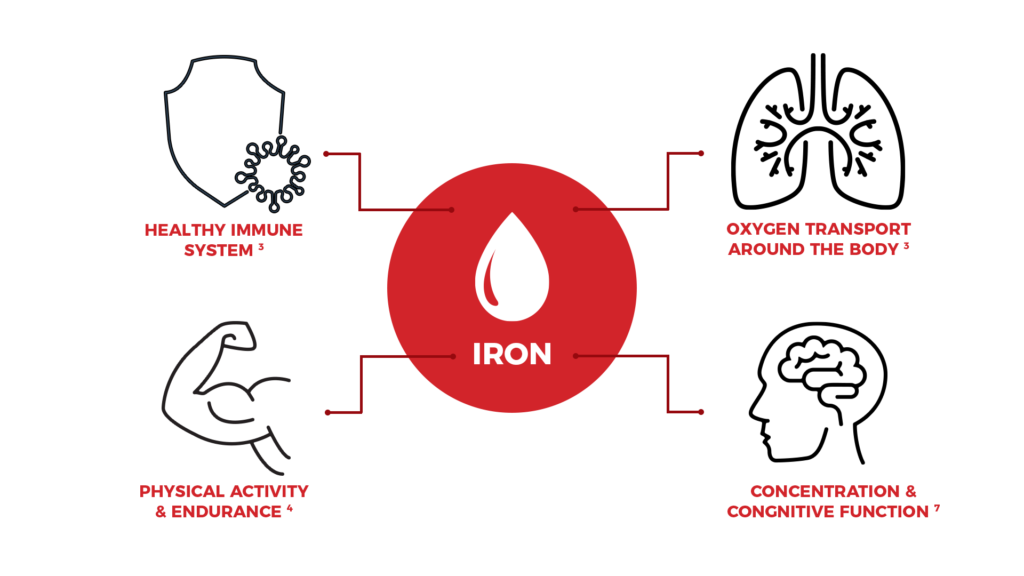Iron is a crucial mineral that our bodies need for various functions. It’s a key component of hemoglobin, the protein in red blood cells that carries oxygen from the lungs to the rest of the body. Without enough iron, our bodies can’t produce sufficient healthy oxygen-carrying red blood cells, leading to fatigue and other health issues.

Functions of Iron:
- Oxygen Transport: Iron is a key part of hemoglobin and myoglobin, proteins that help transport oxygen to the body’s tissues and muscles. Without enough iron, your body cannot effectively deliver oxygen, leading to fatigue and weakness.
- Energy Production: Iron is involved in the production of ATP (adenosine triphosphate), which provides energy to cells.
- Immune Function: Iron plays a role in the development and functioning of immune cells. A deficiency can impair the immune system, increasing susceptibility to infections.
- Cognitive Function: Iron is necessary for brain function, and insufficient levels can affect concentration, memory, and overall cognitive performance.
- Cell Growth and Repair: Iron supports the production and function of collagen, which is vital for the growth and repair of tissues.
Types of Iron:
- Heme Iron: This type of iron is found in animal-based foods (such as meat, poultry, and fish). It is more easily absorbed by the body compared to non-heme iron.
- Non-Heme Iron: Found in plant-based foods (such as beans, lentils, spinach, and fortified cereals), non-heme iron is not as readily absorbed as heme iron. However, the absorption of non-heme iron can be improved when consumed with foods rich in vitamin C (like citrus fruits, tomatoes, or bell peppers).
Recommended Daily Iron Intake:
The recommended amount of iron varies based on age, sex, and life stage:
- Infants (0-6 months): 0.27 mg
- Infants (7-12 months): 11 mg
- Children (1-3 years): 7 mg
- Children (4-8 years): 10 mg
- Children (9-13 years): 8 mg
- Teens (14-18 years): 11 mg for boys, 15 mg for girls
- Adults (19-50 years): 8 mg for men, 18 mg for women
- Adults (51+ years): 8 mg for men, 8 mg for women
- Pregnant Women: 27 mg
- Breastfeeding Women: 9 mg
Sources of Iron:
- Animal-Based (Heme Iron):
- Red meat (beef, lamb)
- Poultry (chicken, turkey)
- Fish (salmon, tuna, sardines)
- Shellfish (oysters, clams, shrimp)
- Plant-Based (Non-Heme Iron):
- Beans and lentils
- Tofu and tempeh
- Spinach and other leafy greens
- Fortified cereals and grains
- Quinoa and pumpkin seeds
- Dried fruits (raisins, apricots, prunes)
- Nuts and seeds
- Foods to Boost Iron Absorption:
- Vitamin C-rich foods (oranges, strawberries, bell peppers, broccoli) can significantly increase the absorption of non-heme iron from plant-based sources.
Iron Deficiency:
Iron deficiency is the most common nutritional deficiency worldwide. It can lead to a condition known as iron deficiency anemia, which occurs when the body doesn’t have enough iron to produce hemoglobin. As a result, the body can’t carry enough oxygen to tissues, causing symptoms like:
- Fatigue
- Pale skin
- Shortness of breath
- Dizziness
- Headaches
- Cold hands and feet
- Weakness
- Brittle nails
Causes of Iron Deficiency:
- Inadequate Dietary Intake: Not consuming enough iron-rich foods.
- Increased Iron Requirements: Pregnant women, growing children, and athletes may need more iron.
- Blood Loss: Heavy menstrual periods, gastrointestinal bleeding, or surgery can lead to significant iron loss.
- Poor Absorption: Conditions like celiac disease, inflammatory bowel disease, or gastric bypass surgery can impair iron absorption.
Iron Overload:
While iron is essential for health, too much iron can lead to a condition called hemochromatosis, which can damage organs like the liver, heart, and pancreas. This condition is usually genetic, but iron overload can also result from excessive iron supplementation. Symptoms of iron overload may include:
- Fatigue
- Joint pain
- Abdominal pain
- Heart problems
- Diabetes
If you suspect you have too much iron, it’s important to seek medical advice to prevent damage to internal organs.
Treatment for Iron Deficiency:
- Iron-Rich Diet: Increasing the intake of iron-rich foods can help treat mild deficiencies.
- Iron Supplements: In cases of significant deficiency, doctors may recommend iron supplements. These are usually taken in the form of ferrous sulfate, ferrous gluconate, or other types of iron salts. Supplements should be taken with caution, as too much iron can cause constipation, nausea, or other side effects.
- Vitamin C: Taking vitamin C with iron-rich foods or supplements can improve absorption.
- Intravenous Iron: In severe cases of iron deficiency anemia that do not respond to oral supplements, intravenous iron injections may be necessary.
Prevention of Iron Deficiency:
- Eat a balanced diet: Ensure you’re consuming both heme and non-heme iron-rich foods.
- Pair with vitamin C: Enhance iron absorption from plant-based sources by consuming them with vitamin C-rich foods.
- Monitor for symptoms: If you’re at risk for iron deficiency (e.g., pregnant women, menstruating women, vegetarians), make sure to regularly monitor your iron levels through blood tests.
* Conclusion *
Iron is a vital mineral that plays a central role in the body’s ability to transport oxygen, produce energy, and support immune function. Ensuring adequate intake through a balanced diet—especially for those at higher risk of deficiency—can help maintain overall health and prevent issues like iron deficiency anemia. If you’re concerned about your iron levels or suspect a deficiency, it’s best to consult with a healthcare provider for proper diagnosis and treatment.
